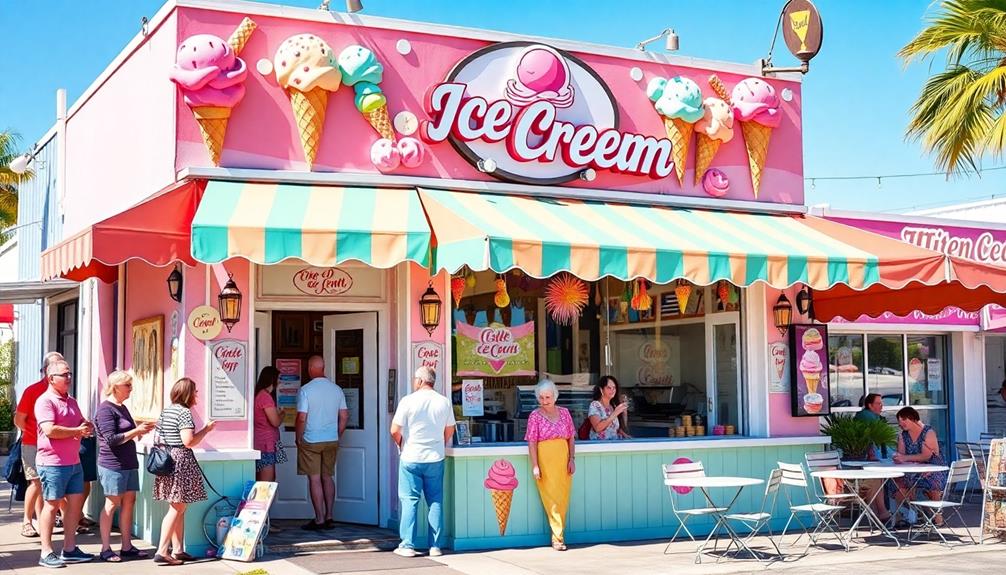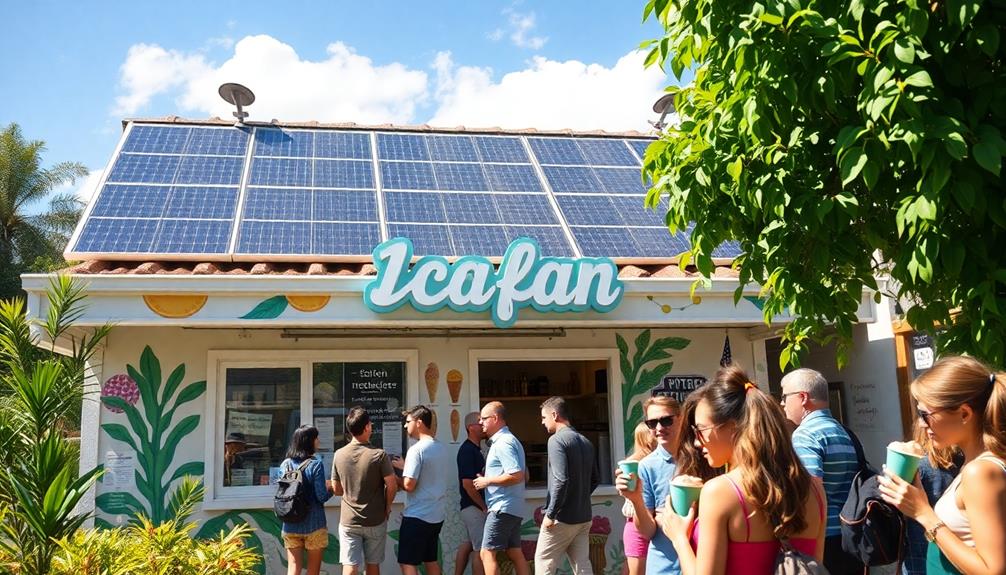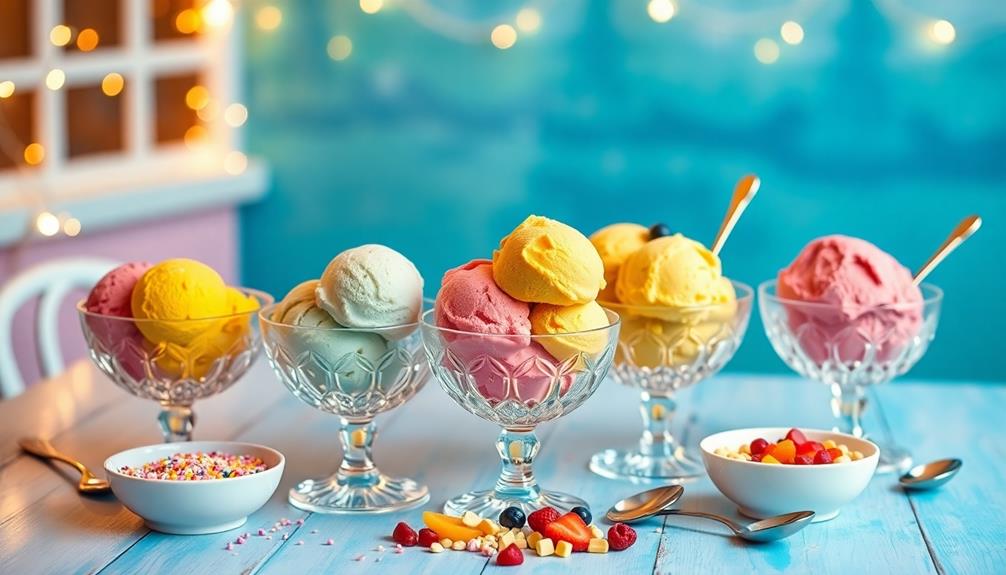Frozen Delights
Where Was Ice Cream Invented? A Sweet History Lesson!
Kick back and discover the origins of ice cream in 200 BC China, from snow to sugar, in a delectable journey through time.

Travel back to 200 BC in China where ice cream originated. From using snow and ice in China, Persia, Greece, and Rome, to becoming a symbol of elegance in ancient societies, ice cream has a rich history. The Middle East introduced milk and sugar to enhance its flavors, while Europe refined it with egg yolks. In America, ice cream gained popularity in the 18th century. Technological advancements like insulated ice houses and refrigeration transformed production. Presidents George Washington and Thomas Jefferson were known to love it. The sweet story of ice cream's journey awaits!
Key Takeaways
- Ice cream was invented in China around 200 BC.
- Greeks, Romans, and Persians used snow and ice for frozen desserts.
- Persians created faloodeh with rose water and saffron.
- Ice cream evolved in Europe with milk and sugar syrups.
- Ice cream made its debut in the US in 1744.
Ancient Origins

Ice cream's ancient origins date back to around 200 BC in China, where a combination of rice and milk was used to create the frozen delicacy. The Chinese and Persians utilized snow and ice to freeze their desserts, turning them into luxury items enjoyed by the elite.
In Ancient Greece, snow combined with honey and fruit juices was used to make sorbet, a precursor to modern ice cream. Importantly, in the Roman Empire, Emperor Nero was known for enjoying flavored ice treats, contributing to the evolution of frozen desserts.
The Persians also had their own version of a frozen delight called faloodeh around 400 BC, which was flavored with rose water, saffron, and fruits. These early creations laid the foundation for the development of ice cream and other frozen desserts, with each culture adding its unique touch to the sweet confection.
Influence of Rome and Greece

In ancient Rome and Greece, the consumption of frozen desserts was intertwined with societal status and culinary sophistication. Greeks delighted in sorbet made from snow, honey, and fruit juices, relishing it as a cool and sweet treat.
Meanwhile, Roman Emperor Nero, in the 1st century AD, played a pivotal role in popularizing flavored ice treats, showcasing them at extravagant banquets for the elite. Romans showcased their innovative spirit by collecting snow from mountains to create ice cream, demonstrating their mastery of freezing techniques.
The elite of ancient Rome and Greece savored ice cream as a luxury, symbolizing their refined tastes and social standing. The introduction of these frozen delights at lavish gatherings by Nero exemplified the importance of indulgence and culinary artistry in these ancient civilizations.
The roots of ice cream in Greece and Rome laid the foundation for its evolution and its eventual spread to other parts of the world.
Evolution in Middle East and Europe

The evolution of frozen desserts in the Middle East and Europe was marked by significant culinary innovations that transformed the traditional concept of sweet treats. Arabs played a crucial role in introducing milk as a key ingredient in ice cream, enhancing its creamy texture and flavor profile. Their use of sugar syrups as sweeteners influenced the development of ice cream in Europe, where it became more accessible to the general public during the 17th century with the establishment of ice cream parlors. Italian refinement of the frozen milk dessert recipe, brought by Marco Polo, included the addition of egg yolks for a richer consistency. Furthermore, Catherine de Medici's introduction of ice cream to the French court in the 16th century contributed to its popularity among European royalty.
| Middle East | Europe | Culinary Innovations |
|---|---|---|
| Arabs | Italian | Milk & Sugar Syrups |
| 17th Century | Marco Polo | Ice Cream Parlors |
| Catherine de Medici | – | Royal Court Influence |
Ice Cream Evolution in America

Let's talk about the evolution of ice cream in America.
Ice cream made its debut in 1744, quickly gaining popularity as seen in the first advertisement in 1777.
Presidents like George Washington and Thomas Jefferson were known ice cream enthusiasts, helping solidify its place in American culture.
American Ice Cream Origins
Explore the evolution of ice cream in America with a focus on its origins and historical significance.
Ice cream made its official debut in the United States in 1744, marking the beginning of a sweet revolution in the New World. The ice cream industry quickly gained momentum, with the first ice cream advertisement appearing in the New York Gazette in 1777.
Notable figures like President George Washington indulged in the frozen treat, spending a substantial $200 on ice cream back in 1790. President Thomas Jefferson, known for his love of ice cream, meticulously followed an elaborate 18-step recipe.
Dolley Madison, the wife of President James Madison, delighted guests by serving strawberry ice cream at a White House banquet in 1813.
Presidential Ice Cream Love
Moving from American Ice Cream Origins, explore the world of Presidential Ice Cream Affection in America. Presidential ice cream love has been an important part of American history, with notable figures like George Washington, Thomas Jefferson, and Dolley Madison showcasing their fondness for this sweet treat.
| President | Ice Cream Affection |
|---|---|
| George Washington | Spent $200 on ice cream in 1790, reflecting early American love for the dessert. |
| Thomas Jefferson | Had an elaborate 18-step ice cream recipe, emphasizing the presidential connection to ice cream. |
| Dolley Madison | Served strawberry ice cream at a White House banquet in 1813, solidifying ice cream's popularity in America. |
These presidential figures played essential roles in the ice cream evolution in the United States, from Jefferson's complex recipes to Madison's White House extravagance. The first ice cream advertisement in 1777 further propelled the dessert into the hearts of early Americans, setting the stage for the rise of ice cream parlors and the eventual shift towards supermarket prepackaged ice cream.
Technological Advances Impact
Technological advances have greatly influenced the evolution of ice cream in America, shaping production, distribution, and consumption habits over the centuries. Innovations such as insulated ice houses, steam power, and mechanical refrigeration have played a pivotal role in transforming the ice cream industry.
Jacob Fussell's establishment of the first ice cream industry in America in 1851 marked a significant milestone, paving the way for mass production and widespread availability. Today, annual frozen dairy production in the U.S. exceeds 6.4 billion pounds, underscoring the profound impact of these technological advancements.
Motorized delivery vehicles have further revolutionized the distribution of ice cream, enhancing efficiency and enabling broader accessibility to this beloved treat.
- Insulated ice houses revolutionized ice cream storage and distribution.
- Jacob Fussell's ice cream industry establishment set the stage for mass production.
- Steam power and mechanical refrigeration boosted ice cream production in the 19th century.
- Annual frozen dairy production in the U.S. surpasses 6.4 billion pounds today.
- Motorized delivery vehicles have enhanced ice cream distribution efficiency.
Technological Advances in Production

Inventing insulated ice houses around 1800 was a pivotal step in storing ice for ice cream production. This development laid the groundwork for the technological advances that would revolutionize the ice cream industry.
With the introduction of steam power and mechanical refrigeration, ice cream production saw a significant boost in efficiency and quality. These innovations not only increased the scale of frozen dairy production but also paved the way for wider distribution of ice cream products.
The integration of motorized delivery vehicles further transformed the ice cream industry, allowing for broader reach and faster delivery times. Today, the frozen dairy annual production in the U.S. exceeds 6.4 billion pounds, a proof to the impact of these technological advancements.
From the humble beginnings of insulated ice houses to the modern era of advanced machinery and logistical systems, the evolution of technology in ice cream production continues to shape the way we enjoy this beloved treat.
Innovations and Cultural Impact

The cultural impact of ice cream innovations has been significant, shaping not only how we enjoy this beloved treat but also influencing culinary trends worldwide.
Here are some key points to take into account:
- The introduction of the ice cream cone at the 1904 St. Louis World's Fair revolutionized the way people consume this frozen dessert.
- Agnes Marshall's contributions in popularizing ice cream recipes and innovations in the late 19th century laid the foundation for modern ice cream creations.
- Technological advancements in ice cream production have led to the creation of over 1,000 varieties, catering to diverse preferences globally.
- The development of soft serve ice cream and iconic desserts like the banana split have played an essential role in shaping ice cream's modern appeal.
- Ice cream's distribution channels expanded through beach vendors, ice cream trucks, and specialty shops, making it easily accessible to people of all ages and cultures.
Frequently Asked Questions
Where Was Ice Cream Invented?
Ice cream was invented in Persia around 500 B.C., known as bastani. Chinese versions emerged using rice and milk. Greeks and Romans enjoyed frozen desserts. Marco Polo brought a recipe to Italy. Cultural exchanges led to modern ice cream.
What Is the Surprising History of Ice Cream?
Discover the surprising history of ice cream! From its origins in ancient Persia to its evolution in Europe and journey to America, this frozen treat has delighted taste buds for centuries with its sweet innovations.
What Was the First Ice Cream Flavor Invented in America?
The first ice cream flavor invented in America was likely vanilla, a classic that remains a top choice today. Early advertisements showcased flavors like strawberry, apricot, and raspberry, paving the way for diverse options.
Who Invented Ice Cream in Persia?
You might wonder who invented ice cream in Persia. Well, around 500 B.C., the Persians crafted the first icy treat. This noble dish called bastani blended ice with grape and fruit juice, a luxurious delight for the elite.
What is the Origin of Ice Cream and Its Sweet History?
The quest to discover ancient ice cream history leads us back to China in 618-97 AD, where the Tang Dynasty enjoyed frozen milk and rice. Later, Marco Polo encountered a similar treat in Italy during the 13th century, leading to the evolution of the sweet, creamy dessert we love today.
Conclusion
So, now you know that ice cream was invented in China over 2,000 years ago!
Did you know that Americans consume about 23 pounds of ice cream per person each year? That's a lot of scoops!
Ice cream has come a long way from its humble beginnings, evolving into a beloved treat enjoyed by people all over the world.
Next time you indulge in a scoop, remember the sweet history behind this delicious dessert.
Beyond the realm of flavor and technique, Adriano recognizes the importance of sustainability and conscious consumption. His writing often explores eco-friendly practices within the ice cream industry, highlighting the use of locally sourced ingredients, reducing waste, and supporting ethical production methods.
Frozen Delights
Best Ice Cream Destinations Around the World
Make your taste buds dance as you explore the world’s best ice cream destinations, where unique flavors await at every turn. Discover the sweetest adventures!

If you're passionate about ice cream, you'll want to visit the best destinations worldwide. Start at Une Glace in Paris for haute couture flavors like pistachio and orange blossom. In Philadelphia, The Franklin Fountain brings nostalgic favorites in a vintage setting. Head to Rome for Il Gelato Di San Crispino's authentic gelato, then to Milk Train in London for cotton candy-topped treats. Don't miss Coconut Glens in Hawaii for coconut-based delights in an ocean-view location. Each stop offers unique flavors and experiences, making your journey a sweet adventure worth exploring further.
Key Takeaways
- Explore iconic ice cream shops like Une Glace in Paris and The Franklin Fountain in Philadelphia for unique flavors and nostalgic experiences.
- Discover regional specialties such as gelato in Italy, frozen custard in the U.S., and kulfi in India, each showcasing local traditions.
- Sample trending flavors including vegan options, savory varieties, and seasonal ingredients at shops worldwide, appealing to diverse taste preferences.
- Visit ice cream destinations that prioritize sustainability through local sourcing, eco-friendly packaging, and waste reduction practices, enhancing your experience.
- Participate in notable ice cream events like the Gelato World Tour and National Ice Cream Day, celebrating the cultural significance of this beloved treat.
Top Ice Cream Shops Worldwide

When it comes to finding the best ice cream shops worldwide, you're in for a treat. You'll discover unique flavors and high-quality artisan ice cream that redefine your dessert experience.
In Paris, Une Glace has gained fame for its homemade ice cream inspired by Haute Couture, featuring signature flavors like pistachio & orange blossom and Ethiopian coffee & black cardamom.
If you find yourself in Philadelphia, The Franklin Fountain offers generous portions of nostalgic favorites, such as mint & dark chocolate and peanut butter, all in a charming vintage setting.
Traveling to Rome? Il Gelato Di San Crispino serves authentic gelato made from high-quality ingredients, boasting unique flavors like fresh walnuts & dried figs and Calabrian licorice.
Over in London, Milk Train offers visually appealing creations, including colorful ice cream teas topped with cotton candy, making your dessert as fun to look at as it's to eat.
Finally, in Hana, Hawaii, Coconut Glens specializes in coconut-based ice creams served in coconut shells, with unique flavors like lilikoi that provide a revitalizing tropical twist.
Each shop promises a delightful ice cream adventure you won't forget!
Regional Specialties and Styles

When you travel the world, you'll discover that ice cream isn't just a one-size-fits-all treat.
Each region boasts its own unique specialties, often crafted from local ingredients and steeped in tradition.
From the creamy richness of frozen custard in the U.S. to the chewy delight of Dondurma in Turkey, there's a whole spectrum of flavors waiting for you to explore.
Unique Global Ice Creams
Ice cream isn't just a summer treat; it's a global phenomenon that takes on unique forms and flavors in different cultures.
For instance, indulge in gelato, the Italian delight known for its dense texture and intense flavors, made with more milk than cream.
If you're in India, don't miss kulfi, a creamy ice cream made from sweetened evaporated milk, often flavored with saffron and cardamom, served in popsicle shapes.
In Turkey, try dondurma, a stretchy ice cream that's fun to eat, thanks to its elastic texture from salep. Vendors perform playful tricks as you savor this delightful treat.
Meanwhile, in Japan, you'll find kakigori, a revitalizing dessert of finely shaved ice topped with sweet syrups like matcha or condensed milk, perfect for hot days.
In Mexico, the vibrant raspado will catch your attention, featuring finely shaved ice drizzled with fresh fruit juices and customizable toppings.
These unique global ice creams showcase diverse culinary traditions, offering a tasty adventure that's hard to resist—especially when served in homemade waffle cones!
Local Ingredients and Traditions
Throughout the world, local ingredients and traditions shape the ice cream experience, creating distinct regional specialties that reflect cultural heritage. Each destination offers unique flavors that tantalize your taste buds.
Here are four traditional desserts that showcase the beauty of local ingredients:
- Gelato (Italy): This artisanal delight, made with whole milk and eggs, boasts intense flavors like pistachio and stracciatella. It's lower in fat, allowing the vibrant flavors to shine through.
- Kulfi (India): A dense and creamy traditional dessert, kulfi is made from sweetened evaporated milk and often flavored with saffron or pistachio, served in a unique popsicle shape.
- Dondurma (Turkey): Known for its elastic, chewy texture, this ice cream features goat milk and salep. Vendors often delight customers with their playful serving style, making it an interactive experience.
- Kakigori (Japan): Perfect for hot summers, this invigorating treat consists of finely shaved ice topped with handmade flavored syrups and often complemented by condensed milk or fresh fruits.
These regional specialties highlight the beauty of local ingredients, crafting unforgettable ice cream experiences around the globe.
Unique and Trending Flavors

Discovering unique and trending flavors in ice cream can feel like starting on a delicious adventure. With shops offering everything from Lavender Honey to Bacon Maple, there's no shortage of unique flavors to tempt your taste buds.
If you're feeling particularly adventurous, try a scoop of cactus or tomato-basil sorbet, like those at Fenocchio in Nice, which feature unexpected ingredients that redefine frozen treats.
Vegan ice cream is also on the rise, with options made from coconut or almond milk. Flavors like salted caramel and chocolate fudge cater perfectly to health-conscious consumers who don't want to miss out on indulgence.
Artisanal ice cream makers are pushing boundaries even further by experimenting with savory flavors, such as basil and olive oil, appealing to food enthusiasts keen for new experiences.
Don't overlook seasonal ingredients; shops often roll out limited-edition treats that showcase local sourcing. Think pumpkin spice in the fall or fresh fruit flavors in the summer.
Each scoop reflects a commitment to quality and creativity, inviting you to explore the ever-evolving world of ice cream. So, grab a cone and indulge in these innovative flavors!
Atmosphere and Customer Experience

When you step into an ice cream shop, the atmosphere plays an essential role in shaping your experience. Each destination offers a unique vibe that enhances your enjoyment of their high-quality products.
Here are four elements that contribute to an unforgettable customer experience:
- Nostalgic Decor: Shops like Eddies Sweet Shop charm visitors with their old-fashioned decor, creating a warm, family-friendly environment perfect for ice cream lovers of all ages.
- Engaging Activities: Simmos Ice Creamery in Australia provides family-friendly activities, making it a fun spot for everyone and fostering lasting memories.
- Quirky Branding: Big Gay Ice Cream in New York captivates a younger crowd with its vibrant atmosphere and playful branding, ensuring your visit is as Instagrammable as it's delicious.
- Upscale Ambiance: Antico Caffè Spinnato in Italy combines a swanky bistro vibe with unique flavors, enhancing the overall enjoyment of your ice cream experience.
These elements not only create an engaging environment but also make each visit to these ice cream shops truly special.
Your experience goes beyond just the ice cream; it's about the memories you create.
Sustainability in Ice Cream Shops

Sustainability is becoming a cornerstone for many ice cream shops, with a growing number embracing eco-friendly practices to reduce their environmental impact. You'll find that these shops prioritize local ingredients, sourcing organic produce from nearby farms to lower their carbon footprint while supporting their community.
This commitment to sustainability extends to their packaging as well; many now use compostable cups and spoons to minimize waste.
Moreover, these ice cream shops often invest in energy-efficient equipment, which helps them lower energy consumption during production. Waste reduction is another key focus, with shops creatively using excess ingredients or donating unsold products to local charities, ensuring that nothing goes to waste.
Ethical sourcing is gaining traction too, with shops adopting fair trade practices for ingredients like cocoa and vanilla, ensuring that farmers receive fair compensation for their hard work.
By choosing ice cream shops that prioritize these eco-friendly initiatives, you're not just indulging in a tasty treat; you're also supporting a movement towards a more sustainable future.
Cultural Significance of Ice Cream

Ice cream isn't just a delightful dessert; it holds deep cultural significance around the world. It's a cultural symbol that reflects local traditions, seasonal flavors, and the joy of social interactions.
Here are some ways ice cream connects us to our cultures:
- Gelato in Italy: This creamy treat represents centuries of culinary excellence and tradition.
- Paletas in Mexico: Made with fresh fruits and local flavors, they symbolize the blend of indigenous ingredients and modern culinary practices.
- Seasonal Festivals in Japan: Unique ice cream flavors highlight local ingredients and bring communities together during celebrations.
- Ice Cream Trucks in the U.S.: They evoke nostalgia, reminding you of carefree summer days and shared moments with friends.
As you enjoy ice cream, you're not just savoring a sweet treat; you're participating in a communal experience that fosters connections and celebrates local customs.
Culinary expert Jeni Britton Bauer emphasizes that ice cream plays a pivotal role in social gatherings, making it more than just a dessert—it's a delicious thread that weaves together communities across the globe.
Notable Ice Cream Events

Across the globe, notable ice cream events draw enthusiasts together to celebrate this beloved treat. One of the highlights is the annual Ice Cream Festival, where families and ice cream lovers indulge in tastings, engage in local flavor competitions, and enjoy entertainment.
It's a perfect outing for those who want to savor unique flavors and support their favorite ice cream shops.
Another prestigious event, the Gelato World Tour, showcases the finest gelato artisans from around the world. Here, you can witness exciting flavor competitions and attend workshops that explore the art of gelato making, making it a must-visit for any serious ice cream enthusiast.
Don't forget National Ice Cream Day, celebrated on the third Sunday of July in the U.S. Ice cream shops roll out special deals and promotions, featuring unique flavors that entice customers to join the festivities.
Additionally, Ice Cream Socials in local parks promote community spirit, allowing people to gather, enjoy ice cream, and support local businesses.
These events truly highlight the joy and creativity surrounding ice cream, making every scoop a reason to celebrate!
Frequently Asked Questions
Which Country Is the Best for Ice Cream in the World?
When it comes to the best country for ice cream, you'll find Italy's gelato irresistible, but the U.S. offers innovative flavors. Japan's unique combinations and France's gourmet experiences also make them strong contenders. Enjoy exploring!
What Is the Best Ice Cream Place on Earth?
When you think about the best ice cream place on earth, you're drawn to unique flavors and experiences. You'll find joy in tasting gelato in Italy or indulging in vintage-style scoops in Philadelphia. Enjoy!
What Is the #1 Ice Cream in the World?
When you crave pure bliss, gelato's your answer. Its rich flavor and creamy texture dance on your taste buds, making it the world's #1 ice cream. You'll savor every luscious spoonful, guaranteed to delight.
What Country Leads the World in Ice Cream Consumption?
You'll find the United States leads the world in ice cream consumption, with Americans devouring about 23 liters per person each year. That passion for ice cream keeps the industry thriving and ever-growing!
Conclusion
Whether you're savoring a classic scoop in a quaint Italian gelateria or indulging in a bold, innovative flavor from a trendy, eco-conscious shop, the world of ice cream is full of surprises. Just as each destination offers its own unique twist on this beloved treat, the joy of ice cream transcends borders and cultures. So, grab your cone and celebrate the sweet moments that connect us, proving that no matter where you are, ice cream always brings a smile.
Beyond the realm of flavor and technique, Adriano recognizes the importance of sustainability and conscious consumption. His writing often explores eco-friendly practices within the ice cream industry, highlighting the use of locally sourced ingredients, reducing waste, and supporting ethical production methods.
Frozen Delights
How to Host an Ice Cream Tasting Party
Host an unforgettable ice cream tasting party with unique flavors, fun activities, and creative presentations—discover the key ingredients for a sweet success!

Hosting an ice cream tasting party is a delightful way to gather friends and family. Start by selecting a mix of classic and unique flavors, including dairy-free options for everyone to enjoy. Set up a tasting station with ice-filled buckets, plastic cups, and spoons. Provide scorecards for ratings, adding a touch of competition. Engage guests with fun activities like "Guess the Flavor" or a flavor creation contest. Don't forget to present the ice cream in visually appealing ways, like using mason jars or custom wrappers. With these tips, you'll create an unforgettable experience that everyone will love. There's so much more to explore!
Key Takeaways
- Select a diverse range of ice cream flavors, including classics and unique options, to cater to all tastes and dietary restrictions.
- Set up a dedicated tasting station with ice-filled buckets, cups, and spoons for easy sampling and organized flavor rating.
- Engage guests with interactive activities like flavor creation contests and guessing games to enhance the experience and foster camaraderie.
- Create an appealing presentation using decorative bowls, custom wrappers, and a "Flavor of the Day" board to impress attendees.
- Provide printable scorecards for flavor ratings and ensure a fun atmosphere with creative decorations and health-conscious options.
Ice Cream Taste Test Overview

An ice cream taste test is a delightful way to bring friends and family together for a fun-filled gathering. This engaging activity is perfect for family reunions or any group event, allowing everyone to sample and rate a variety of ice cream flavors.
Whether you're hosting an ice cream party at home or on vacation, it creates an interactive experience where participants can bond over delicious treats.
To organize the taste test, provide each guest with their own plastic cup and spoon, ensuring a personalized tasting experience. As they savor different flavors, they can use a free printable scorecard to record their ratings, adding an organized touch to the event.
This friendly competition encourages interaction and lively discussions about preferences and favorites.
You'll find that the ice cream taste test not only serves as a revitalizing summer dessert but also brings a sense of excitement and camaraderie among participants.
Selecting Ice Cream Flavors

When selecting ice cream flavors for your tasting party, aim for a mix of classic favorites and unique options to excite your guests' taste buds.
Consider incorporating seasonal and local flavors to enhance the experience further.
Don't forget to mix brands and flavors, creating fun combinations that encourage everyone to explore new tastes together.
Flavor Variety Selection
Selecting the right ice cream flavors is essential for a successful tasting party. You'll want to choose a diverse range of flavors that cater to different palates. Start with classic options like vanilla and chocolate, then add some delicious unique varieties such as Peach Crisp and Unicorn Sparkle.
Including both creamy and fruity selections guarantees a balance that appeals to everyone.
Don't forget to take into account dietary restrictions! By incorporating dairy-free and vegan options, you'll allow all your guests to enjoy the delicious ice cream experience.
Additionally, sourcing local or seasonal flavors not only enhances your tasting party but also supports regional farmers, giving a special touch to your selection.
Mixing Brands and Flavors
Mixing brands and flavors can elevate your ice cream tasting party, creating a memorable experience for your guests. Choose a variety of flavors of ice cream from different brands, like Great Value's Circus Cookie and Unicorn Sparkle, to keep things exciting. You can balance unique flavors like Sea Salt Caramel with a classic Vanilla Float, surprising and delighting participants.
To guarantee everyone has something they love, incorporate both creamy and fruity options. Here's a quick reference table to help you select:
| Flavor Type | Flavor Suggestions |
|---|---|
| Creamy | Sea Salt Caramel, Vanilla Float |
| Fruity | Peach Crisp, Root Beer |
Seasonal and Local Options
Incorporating seasonal and local options can take your ice cream tasting party to the next level. Start by mixing classic flavors like vanilla and chocolate with unique seasonal flavors. Think pumpkin spice in the fall or fresh berry blends in the summer. These seasonal flavors not only excite your palate but also highlight the time of year.
Don't forget to include local ingredients. Seek out flavors inspired by regional fruits or beloved desserts from nearby bakeries. For instance, using honey from local farms or fruits from your area's orchards can elevate the flavor profile and create a fresh, authentic taste.
Additionally, consider offering dairy-free and vegan options, like coconut or almond milk-based ice creams. This guarantees everyone can enjoy the tasting, regardless of dietary restrictions.
Seasonal specialties, such as mint chocolate chip in the spring or eggnog in the winter, add a festive touch to your selection. By thoughtfully curating your flavors with seasonal and local options, you'll enhance the tasting experience and support local businesses, making your party memorable for all your guests.
Setting Up the Tasting Station

To create an enticing ice cream tasting station, start by designating a specific area where guests can easily access a variety of flavors. Use galvanized buckets filled with ice to keep the ice cream chilled and inviting throughout the event.
Arrange the different flavors in a way that encourages sampling, making it easy for guests to navigate. Provide each participant with a plastic cup and spoon for sampling. This will allow them to taste and evaluate each flavor comfortably.
To enhance the experience, use large popsicle sticks or wooden spoons as flavor markers, clearly labeling each ice cream option available. This way, everyone knows what they're tasting.
Additionally, offer a printable scorecard for guests to rate the flavors on a scale of 1-5. This organized tracking will help them remember their favorites.
Engaging Guests With Activities

To keep the energy high at your ice cream tasting party, consider organizing a fun flavor creation contest where guests can mix and match toppings for their own unique concoctions.
Pair this with interactive games like "Guess the Flavor" to spark some friendly competition.
These activities won't only engage everyone but also create unforgettable memories throughout the event.
Fun Ice Cream Games
At an ice cream tasting party, engaging guests with fun games can elevate the experience and create lasting memories. Start with "Pin the Cherry on the Sundae," where players aim to stick a cherry on a giant sundae poster while blindfolded, adding a competitive twist to the event.
Next, organize a "Guess the Flavor" challenge, where blindfolded participants taste various ice creams and try to identify the flavors—it's a delightful sensory experience!
Consider hosting a sundae-eating contest to see who can craft and consume the most elaborate sundae in a set time. This encourages creativity and fun while showcasing everyone's unique styles.
For a team-building activity, set up an ice cream cone relay race. Teams race to fill and balance cones with different toppings, fostering excitement and laughter among guests.
Lastly, create a DIY station where participants can mix their own flavor combinations, allowing them to experiment and share their creations. This interactive element will surely spark conversations and enhance the ice cream-themed atmosphere.
With these games, your party will be a hit, and everyone will leave with sweet memories!
Flavor Creation Contest
Hosting a flavor creation contest can transform your ice cream tasting party into an unforgettable experience, as guests release their creativity and culinary skills. Start by providing a selection of homemade ice cream bases alongside unique mix-ins, encouraging everyone to experiment and invent their own signature flavors.
Set up a judging panel with attendees or family members who can taste and score each creation on creativity, taste, and presentation. Use scorecards to keep things organized and fair. To spice up the competition, offer fun prizes in categories like "Most Creative Flavor" or "Best Presentation." This adds a motivational edge to the event.
Encourage contestants to name their flavors and share a short description of their inspiration. This personal touch fosters storytelling and camaraderie among guests.
Don't forget to capture the moment—take photos of each creation! You might even want to display the winning entries on a "Flavor of the Day" board for future reference and to spark fond memories.
Creative Presentation Ideas

Elevating your ice cream tasting party with creative presentation ideas can transform a simple gathering into an unforgettable experience.
Start by setting up an ice cream sample bar using galvanized buckets filled with ice. This not only keeps the ice cream cold but also gives your event a fun parlor-like vibe.
To enhance the tasting experience, consider these presentation ideas:
- Use mason jars for showcasing different ice cream flavors. Pair them with small tasting spoons, allowing guests to sample without the mess.
- Implement large popsicle sticks or wooden spoons as flavor markers. This way, guests can easily identify and remember their favorite ice cream flavors.
- Design custom ice cream cone wrappers using blank templates that guests can personalize. This adds a creative touch while serving their treats.
Don't forget to incorporate vibrant colors and themed decorations, like ice cream cone balloons, to create a festive atmosphere.
With these creative presentation ideas, your ice cream tasting party won't only be delicious but also visually delightful, leaving a lasting impression on your guests.
Tips for a Successful Party

Creating a memorable ice cream tasting party involves more than just delicious flavors and appealing presentations. Start by setting up an ice cream sample bar with galvanized buckets filled with ice. This keeps your flavors chilled and accessible for guests enthusiastic to take a small scoop from each option.
Consider offering health-conscious options such as lower-calorie ice creams or lactose-free varieties to accommodate different dietary preferences.
To engage your participants, provide a free printable scorecard where they can rate each flavor on a scale of 1-5. This promotes friendly competition and makes the taste test more interactive.
Make sure to organize a diverse selection of ice cream flavors, including unique options like Sea Salt Caramel and Unicorn Sparkle, to cater to different tastes.
Enhance the atmosphere with creative decorations, like ice cream cone balloons and a themed photo booth. These details create an inviting space that encourages fun.
Additionally, plan interactive activities such as flavor guessing games or an ice cream flavor creation contest. These activities keep your guests entertained and involved throughout the event.
Frequently Asked Questions
How Do I Host an Ice Cream Tasting?
To host an ice cream tasting, choose diverse flavors, set up a tasting station with cups and scorecards, and organize the tasting sequentially. Engage participants with palate cleansers and fun decorations for an enjoyable experience.
How Do You Make an Ice Cream Party Fun?
An ice cream party can be the most epic celebration ever! Transform the space with vibrant decorations, set up a topping bar, and plan fun games to keep everyone laughing and enjoying the sweet moments together.
How to Do an Ice Cream Taste Test?
To do an ice cream taste test, set up a tasting station with cups and spoons. Offer diverse flavors, let participants rate them on scorecards, and encourage them to share their thoughts after sampling.
What Do You Serve at an Ice Cream Party?
At your ice cream party, serve a delightful symphony of flavors, from classic vanilla to wild Unicorn Sparkle. Add a topping bar, colorful accessories, and pre-scooped servings for a sweet experience everyone will savor.
Conclusion
Hosting an ice cream tasting party is a fun way to indulge in delicious flavors while creating lasting memories with friends and family. Did you know that the average American eats about 23 pounds of ice cream each year? That's a lot of scoops! By carefully selecting flavors, setting up an inviting tasting station, and incorporating engaging activities, you'll guarantee your party is a hit. So grab those cones and get ready for a sweet celebration!
Beyond the realm of flavor and technique, Adriano recognizes the importance of sustainability and conscious consumption. His writing often explores eco-friendly practices within the ice cream industry, highlighting the use of locally sourced ingredients, reducing waste, and supporting ethical production methods.
Frozen Delights
Ice Cream Gift Ideas for Various Occasions
Navigate through delightful ice cream gift ideas for every occasion and discover the perfect treat to brighten someone’s day!

Ice cream gifts are perfect for any occasion, offering sweetness and joy. For birthdays, consider personalized pints or ice cream-themed gift baskets. If someone's under the weather, they'll appreciate a comforting ice cream gift box with their favorite flavors. Sending sympathy? A Special Occasion 4 Pint Ice Cream Gift can lighten the mood. During the holidays, DIY sundae kits bring family fun. Don't forget customizable baskets and fun accessories like themed spoons for extra flair. No matter the occasion, there's an ice cream gift that's sure to please. Keep exploring to discover more creative ideas!
Key Takeaways
- Special Occasion Ice Cream Gift Sets, including multiple pints, make perfect birthday and holiday gifts for sharing joy.
- Personalized Ice Cream Pints allow customization of flavors, adding a heartfelt touch for get well and sympathy gifts.
- DIY Sundae Kits offer fun and interactive experiences for families, ideal for celebrations like National Ice Cream Day.
- Themed Ice Cream Gift Baskets, such as Chocolate Lovers or Tropical Paradise, enhance the gifting experience with curated flavors and toppings.
- Fun accessories like custom spoons and waffle cone makers elevate the overall ice cream enjoyment for recipients of all ages.
Perfect Birthday Gifts

When it comes to finding the perfect birthday gifts, you can't go wrong with ice cream! An Ice Cream Gift like the Special Occasion 4 Pint Ice Cream Gift, priced at $79.99, is sure to delight. It includes four pints of dense, creamy ice cream and even a free pint, ensuring the birthday celebration is sweet and memorable.
Birthday Ice Cream Gifts have received high satisfaction rates, making them a popular choice among gift-givers and recipients alike. You can add a personal touch by opting for Personalized Pints, letting you customize flavors for your friends and family.
To amp up the fun, consider ice cream-themed gift baskets filled with favorite toppings and sundae essentials. This interactive experience encourages everyone to create their perfect sundae.
You might also want to include unique ice cream spoons or themed apparel, like ice cream T-shirts, to enhance the celebration.
With so many delightful options, your birthday gift won't only satisfy cravings but also create lasting memories. So go ahead and treat your loved ones to the ultimate ice cream experience—they won't forget it!
Thoughtful Get Well Options

When someone you care about is on the mend, ice cream can be a sweet way to brighten their day.
Personalizing your gift with their favorite flavors shows you're thinking of them, and unique combinations can make the treat even more special.
Let's explore how healing with ice cream can lift spirits during recovery.
Healing With Ice Cream
There's something uniquely comforting about ice cream, especially when you're feeling under the weather. An ice cream gift box can be a delightful surprise for someone recovering from an illness. It's more than just a treat; it's a gesture of care and love.
| Ice Cream Flavor | Comfort Factor | Recipient Reaction |
|---|---|---|
| Chocolate Fudge | High | "This made my day brighter!" |
| Vanilla Bean | Moderate | "So creamy, I felt pampered!" |
| Strawberry Swirl | High | "Felt like a hug in a bowl!" |
| Mint Chocolate Chip | Moderate | "Refreshing and uplifting!" |
The Get Well Ice Cream Gift includes four pints of dense and creamy ice cream, plus a free pint to enjoy. Recipients often express surprise and joy upon receiving this thoughtful gift. Personalization options allow you to cater to their favorite flavors, making it even more special. With excellent customer service and quality packaging, this ice cream gift box enhances the overall experience, ensuring it becomes a cherished symbol of your support during their healing journey.
Personalized Touch Matters
A personalized touch can turn a simple ice cream gift into a cherished memory, especially for someone on the mend.
Personalized ice cream gifts not only bring comfort but also show that you care. Here are some thoughtful options to contemplate:
- Custom Engraved Spoons: Add a special message or the recipient's name to a spoon, making each scoop a reminder of your support.
- Tailored Pint Flavors: Choose their favorite flavors or mix in unique ones to match their taste, creating a delightful surprise.
- Handwritten Notes: Including a heartfelt note can uplift spirits, providing encouragement and warmth during recovery.
- Personalized Packaging: Use custom packaging that reflects the recipient's personality, enhancing the overall experience.
These personalized ice cream gifts not only satisfy cravings but also convey your thoughtfulness.
Recipients often express joy and gratitude upon receiving such gifts, reinforcing the emotional impact during tough times.
Unique Flavor Combinations
Exploring unique flavor combinations can transform a simple ice cream gift into a delightful and comforting treat for someone on the mend. When you choose flavors thoughtfully, you create a unique gift that not only pleases the palate but also supports recovery. Consider soothing options like lavender honey or ginger peach, which offer comforting qualities.
Here's a handy table to inspire your choices:
| Flavor Combination | Benefits | Why It's Unique Gift |
|---|---|---|
| Lavender Honey | Calming | Floral notes soothe the mind |
| Mint Chocolate Chip | Invigorating | Classic with a revitalizing twist |
| Tart Cherry Probiotic | Health benefits | Supports digestion while indulging |
Including flavors like chamomile or mint can enhance the healing process, while personalized pints allow recipients to enjoy their favorite tastes, showcasing your thoughtfulness. You can also mix in classic flavors like salted caramel with innovative ones like matcha green tea to cater to various preferences. This way, your ice cream gift not only delights but also aids in recovery, making it a truly unique gift.
Unique Sympathy Treats

Finding the right way to comfort someone who's grieving can be challenging, but unique sympathy treats like ice cream gifts can truly lift spirits.
An ice cream gift box filled with delicious flavors offers a sweet distraction during difficult times. Here are some thoughtful options to reflect upon:
- Special Occasion 4 Pint Ice Cream Gift: This set features four pints of dense, creamy ice cream, perfect for sharing with family or enjoying alone.
- Personalized Ice Cream Pints: Customize pints with unique artwork, making them a heartfelt keepsake that expresses your support and love.
- Get Well Ice Cream Gift: Many testimonials highlight the positive impact of this gift, showing how ice cream can provide comfort during emotional distress.
- Tailored Flavors: Choose flavors that resonate personally with the recipient, ensuring that your gift feels intimate and meaningful.
Creative Holiday Gifts

Surprise your loved ones this holiday season with creative ice cream gifts that bring joy and sweetness to their celebrations. Ice cream gift sets, like the Special Occasion 4 Pint Ice Cream Gift priced at $79.99, make for a thoughtful and memorable present. Tailored selections guarantee that everyone can enjoy their favorite flavors during festive gatherings.
Consider putting together DIY ice cream sundae kits, which include everything needed to create delicious sundaes at home. These kits are perfect for family fun or entertaining friends.
If you want something unique, look for ice cream-themed decor items, such as handmade lamps inspired by ice cream shapes. They add a delightful touch to any space and make great conversation starters.
Ice cream gift baskets are another versatile option. Combine sundae kits with themed toppings to create a delightful surprise for teachers, friends, or family. This way, you're not just giving a gift; you're providing a fun experience that everyone can enjoy.
With these creative holiday gifts, you'll spread cheer and fill hearts with sweetness this season.
Personalized Ice Cream Gifts

Personalized ice cream gifts bring a unique touch to any celebration, making them perfect for friends and family who adore this sweet treat.
From custom engraved spoons to themed apparel, these gifts cater to every ice cream enthusiast's taste. Here are some fantastic options to evaluate:
- Custom Engraved Spoons: Perfect for special occasions like Father's Day or anniversaries, starting at CZK 436.32 for standard designs and CZK 179.72 for premium stainless steel.
- Personalized Ice Cream Scoop Gift Sets: Tailored for events like housewarming parties, these sets are priced around CZK 570.52 and are ideal for those who love to indulge in ice cream.
- Themed Apparel and Accessories: Discover quirky clothing and accessories featuring ice cream designs, often available at discounts of up to 40%.
- Unique Items: Consider personalized mugs or themed jewelry for a creative twist on traditional gifts.
These personalized ice cream gifts not only show thoughtfulness but also create lasting memories.
Whether it's for a birthday, holiday, or just because, these gifts are sure to delight!
DIY Sundae Kits

If you're looking for a fun and interactive gift idea, DIY Sundae Kits are a fantastic option. These kits come packed with everything you need to create personalized ice cream sundaes right at home, making them perfect for celebrations like National Ice Cream Day.
You can customize your Cream Gift Box with a variety of toppings like sprinkles, chocolate syrup, and fresh fruits, catering to everyone's unique tastes.
Assembling a DIY Sundae Kit is simple and can be tailored for any occasion, whether it's a birthday, holiday, or just a thoughtful surprise for friends and family.
To make it even more special, consider including printed recipe cards or themed decorations that add an interactive twist to the experience.
Plus, DIY Sundae Kits can be budget-friendly! You can mix and match ingredients according to your budget while still delivering a memorable treat.
By putting together a delightful kit, you're not just gifting ice cream; you're creating a fun experience that loved ones will cherish.
Ice Cream Gift Baskets

Ice cream gift baskets are a fantastic way to show you care, especially when you customize them with your recipient's favorite flavors and toppings.
You can get creative with themed baskets for different occasions, making each gift unique and memorable.
Plus, with options for tasty extras like cookies and chips, you'll enhance the whole ice cream experience.
Creative Basket Themes
When it comes to creating the perfect ice cream gift basket, the theme you choose can elevate the experience to a whole new level. For ice cream lovers, a well-thought-out theme not only makes the basket visually appealing but also personalizes the gift.
Here are some creative ideas for themed baskets:
- Chocolate Lovers: Fill this basket with an assortment of chocolate ice cream, fudge toppings, and chocolate-dipped treats.
- Tropical Paradise: Include fruity flavors like coconut and pineapple, paired with tropical toppings like shredded coconut and mango chunks.
- Classic Sundae Party: Equip your basket with sundae cups, spoons, and napkins, along with traditional toppings like sprinkles, whipped cream, and cherries.
- Mini Treats Galore: Add cookies, candies, and sprinkles for a fun mix of textures and flavors that enhance the ice cream experience.
Customizable Gift Options
Customizable ice cream gift baskets offer endless possibilities to delight any ice cream enthusiast. You can create a unique experience by including a variety of toppings, sauces, and sprinkles tailored to the recipient's preferences. This personal touch makes ice cream gift baskets a thoughtful gift option for birthdays, holidays, or just because.
Consider theming your basket to match specific occasions. For example, you might incorporate festive flavors or decorations for a holiday celebration. Assembling these baskets is easy and can be done with simple ingredients like cones, chocolate syrup, and whipped cream, allowing you to add a fun DIY element to your gift-giving.
Including a selection of ice cream flavors lets recipients make their own sundaes at home, turning the gift into an interactive experience. To elevate the gift further, think about adding fun items like ice cream-themed mugs or spoons.
These additions make the basket not only delicious but also a memorable keepsake. Customizable ice cream gift baskets truly combine creativity and personalization, ensuring your gift will be cherished and enjoyed.
Fun Ice Cream Accessories

Who doesn't love a scoop of ice cream made even better with fun accessories?
Elevating your ice cream experience can be simple and enjoyable. Here are some fantastic accessories you should consider:
- Custom Stamped Spoons: Available on Etsy for just $10, these spoons add a personal touch to your ice cream enjoyment.
- Waffle Cone Maker: The Proctor Silex model, priced at $37, lets you whip up delightful homemade waffle cones, making every scoop even more special.
- Whipped Cream Dispenser: The Chef Master .5 Liter Whipped Cream Dispenser, available for $27, provides a steady supply of fresh whipped cream to top off your favorite desserts.
- Oslo Ice Cream Spoons: Priced at $42 from MoMA Design Store, these sleek and colorful spoons not only look great but also enhance your overall ice cream experience.
Sweet Gifts for Kids

Ice cream isn't just a treat; it's a source of joy and creativity for kids. If you've got an ice cream lover in your life, consider gifting them ice cream-themed presents that spark their imagination.
Personalized sundae kits are perfect birthday gifts, letting kids craft their own ice cream masterpieces. Imagine their excitement as they mix flavors and toppings!
Customized ice cream spoons with fun designs or their names engraved add a personal touch that makes ice cream time even more special.
For a fun twist, unique ice cream lamps or colorful wall art can brighten up their room, showcasing their love for sweets in a stylish way.
You can also create a DIY ice cream sundae gift basket filled with all the essentials—toppings, sprinkles, and more—transforming dessert into an interactive experience.
Ultimately, don't forget about ice cream-themed apparel! T-shirts featuring fun designs allow kids to flaunt their love for ice cream wherever they go.
These sweet gifts are sure to delight any young ice cream lover and create lasting memories.
Frequently Asked Questions
What Are Good Ice Cream Combinations?
You'll love classic combinations like chocolate ice cream with peanut butter sauce or vanilla topped with fresh strawberries. Mint chocolate chip with brownies adds texture, while lavender with honey offers a unique floral twist. Enjoy experimenting!
What Do You Serve at an Ice Cream Party?
At an ice cream party, you'll serve various flavors, from classic to unique. Provide toppings like sprinkles and whipped cream, offer waffle cones, and set up a sundae bar for guests to create customized treats.
What Are the 12 Types of Ice Cream?
You'll find 12 types of ice cream, including classic flavors like vanilla and chocolate, unique options like mint chocolate chip, and alternatives like gelato, sorbet, soft serve, and frozen yogurt, catering to all tastes.
What Can You Get From Ice Cream?
Did you know that the average American eats about 23 pounds of ice cream each year? You can enjoy various flavors, toppings, and combinations, creating delightful experiences that range from invigorating treats to indulgent desserts.
Conclusion
Whether you're celebrating a birthday with a vibrant scoop of birthday cake ice cream or offering a soothing bowl of vanilla for someone feeling under the weather, ice cream serves as a sweet symbol of joy and comfort. Picture a festive sundae kit beside a heartfelt sympathy treat, each bringing its own warmth to an occasion. From personalized gifts to fun accessories, you'll find that ice cream can turn any moment into a delightful experience worth savoring.
Beyond the realm of flavor and technique, Adriano recognizes the importance of sustainability and conscious consumption. His writing often explores eco-friendly practices within the ice cream industry, highlighting the use of locally sourced ingredients, reducing waste, and supporting ethical production methods.
-

 Frozen Delights3 months ago
Frozen Delights3 months agoThis New Ice Cream Trend Is Taking Over the Internet – Have You Tried It?
-

 Ice Cream Recipes3 months ago
Ice Cream Recipes3 months agoBerry Goodness: Best Strawberry Milkshake Recipe With Ice Cream!
-

 Frozen Delights2 months ago
Frozen Delights2 months agoBest Gelato in Napoli – Neapolitan Delights
-

 Frozen Delights2 months ago
Frozen Delights2 months agoBest Gelato in Firenze – Florence's Sweet Spots
-

 Ice Cream Recipes3 months ago
Ice Cream Recipes3 months agoNo Ice Cream, No Problem: Best Strawberry Milkshake Recipe Without Ice Cream!
-

 Frozen Delights2 months ago
Frozen Delights2 months agoBest Gelato in Philly – Philadelphia's Finest
-

 Frozen Delights3 months ago
Frozen Delights3 months agoBest Gelato in Pisa – Sweet Treats in the City of the Leaning Tower
-

 Ice Cream Recipes3 months ago
Ice Cream Recipes3 months agoExotic Treat: Best Ube Ice Cream Recipe!


































